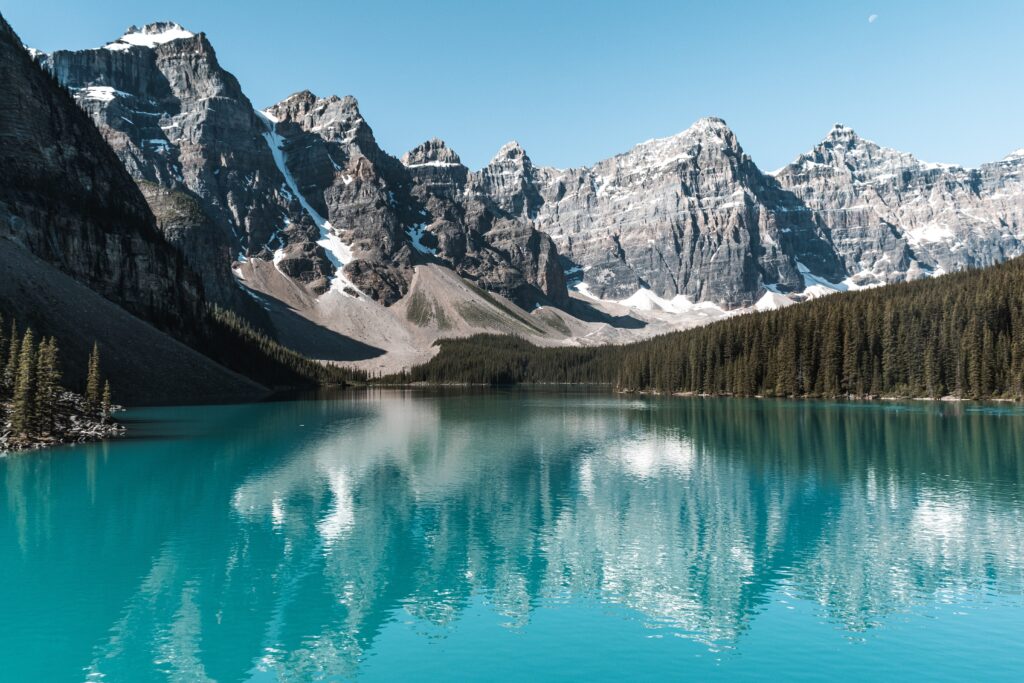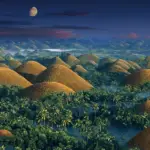The Magnificent Moraine Lake: A Living Painting of Canadian Nature

THE Moraine Lake, located in province of Alberta, is widely considered one of the Canada's most stunning and iconic destinationsIts stunning landscapes, crystal-clear waters, and majestic mountains enchant visitors from all over the world.
With its unparalleled natural beauty, the lake has become a true Canadian treasure. Moraine Lake is situated in the heart of the Canadian Rockies, in one of the most picturesque areas of the country.
Its prime location approximately 15 kilometers south of the city of Lake Louise offers travelers Easy access to this natural wonder. Surrounded by imposing peaks like the Wenkchemna Mountains and the Valley of the Ten Peaks, the lake creates a spectacular setting that attracts nature lovers and photography enthusiasts.
Moraine Lake's most striking feature is its incredible turquoise color. The shimmering waters vary in hue depending on the weather conditions and season.
This unique hue is the result of mineral sediments suspended in the water from the surrounding glaciers. It's hard not to be captivated by the intensity of this vibrant blue that catches the eye.
The Stunning Beauty of Moraine Lake
Moraine Lake is truly a sight to behold, with its stunning natural beauty that leaves even the most seasoned traveler speechless. Located in the magnificent Canadian Rockies, the lake is surrounded by majestic mountains that seem to touch the sky.
The sight of the lake's crystal-clear waters, reflecting the grandeur of the surrounding mountains, creates a breathtaking landscape. The waters of Moraine Lake are simply mesmerizing.
With crystal-clear transparency, even the smallest details at the bottom of the lake are clearly visible. The purity and clarity of the water are almost magical, creating a mirror-like effect that perfectly reflects the stunning surrounding landscapes.
Visitors feel as if they're in a parallel world of incomparable beauty. But perhaps one of Moraine Lake's most striking features is the unique color of its waters.
It's as if the universe itself has poured tons of vibrant blues and greens into the lake's depths. The hues range from a deep blue-green to a brilliant, mesmerizing turquoise, depending on the sun's position and the amount of minerals suspended in the water.

The Hidden Meaning Behind Colors
The magnificent color of Moraine Lake isn't just a whim of nature; there's a whole science behind this kaleidoscopic beauty. The explanation lies in the mineral sediments present in the lake's waters.
During glacial erosion, these minerals were ground into fine particles and suspended in the water, reflecting sunlight in a unique way. Scientists say the blue-green color is primarily due to the presence of ground rock particles known as "rock flour," while the bright turquoise hue is the result of light scattering by clay minerals in the water.
The refractive properties of these minerals create a spectacular visual spectacle, making visitors wonder if they are witnessing something real or merely an enchanted dream. This vibrant and distinct color palette is also intrinsically linked to the natural elements surrounding the lake.
The sun's rays, combined with the altitude of the surrounding mountains and its unique geological composition, contribute to the intensity and variation of the colors of the waters in Moraine Lake. It is a true feast for the eyes and an inexhaustible source of artistic inspiration.
The Glacial Awakening
To understand the geological formation of magnificent Moraine Lake, we must travel back in time to the last ice age, when vast glaciers covered the highlands of the Canadian Rockies. Over this millennia-long period, glacial movements carved the rocky terrain, creating beautiful valleys and steep escarpments.
It was in this monumental setting that Moraine Lake came to life. Glacial erosion played a crucial role in the lake's formation.
As glaciers advanced and retreated throughout the glacial cycles, immense blocks of ice carried with them countless particles of rock and sediment. These materials were deposited as the ice melted, creating a natural dam in the mountain valley.
The accumulated water gradually filled the rocky depression to form Moraine Lake as we know it today. Furthermore, a remarkable aspect of the aquatic landscape is its unique and dazzling color.
The spectacular hue of Moraine Lake's waters is the result of the presence of mineral sediments suspended on its surface. These sediments are composed primarily of fine clay and silt from the erosion of surrounding rocks.
As sunlight penetrates the waters, mineral particles reflect specific wavelengths, producing vibrant hues from blue-green to brilliant turquoise. It's a truly captivating sight that draws visitors from around the world to gaze at this natural wonder.

The Dance of Minerals
The process that triggered the formation of Moraine Lake is a true geological spectacle. Mineral sediments suspended in the water are responsible for giving the lake its characteristic, dazzling color. The fine clay and silt present in these particles are composed of a variety of minerals, including calcite, dolomite, and silica.
As the sun's rays hit the lake's surface, a fascinating phenomenon occurs. White light is composed of different wavelengths corresponding to visible colors.
When sunlight strikes the minerals suspended in the water of Moraine Lake, some colors are absorbed while others are reflected back to our eyes. This interaction between sunlight and mineral particles results in a stunning chromatic spectacle.
The quantity and concentration of these sediments directly influence the lake's color intensity. During certain times of the year, when glacial flow brings more sediment to the calm waters of Moraine Lake, the color reaches its most vivid.
On the other hand, during periods of less glacial activity, the lake can present a softer, more subtle hue. This dance of minerals in the lake water is a testament to the incredible interplay between the natural elements that shape this unique landscape.

Diverse ecosystem around Moraine Lake
lush flora that grows on the slopes of the surrounding mountains
The ecosystem surrounding Moraine Lake is a true natural wonder, with a rich variety of plants and vegetation thriving on the slopes of the majestic surrounding mountains. The region's cool, humid climate, coupled with abundant sunlight, creates ideal conditions for the growth of lush and diverse flora.
On the lower slopes, dense forests of pine and fir trees can be found, their green canopies creating a fairytale-like setting around the lake. These trees provide refreshing shade during hot summer days and are home to a variety of birds and small animals.
The tranquil atmosphere of these woods is often interrupted by the pleasant sound of leaves rustling in the wind. As one ascends the mountains toward higher altitudes, the landscape begins to gradually change.
Forests give way to vast alpine meadows teeming with colorful wildflowers, creating a multicolored carpet in summer. Vibrant purple lupines, bright yellow daisies, and delicate alpine lilies punctuate the stunning scenery around the lake.
the variety of wildlife that inhabits the region
Moraine Lake and its surroundings are home to a rich diversity of wildlife, which benefits from the favorable conditions provided by this unique ecosystem. Common species found in the area include moose, deer, squirrels, and rabbits, which can be easily spotted while walking the trails around the lake. For bird lovers, Moraine Lake is a true paradise.
Cormorants, ospreys, and loons are just some of the majestic birds that frequent the lake's waters in search of food. Furthermore, the birds' melodious songs fill the air during spring and summer, creating an enchanting natural symphony.
The presence of predators is also evident in the Moraine Lake region. Black bears and grizzlies are found in the mountains near the lake, and these impressive creatures are a constant reminder of the importance of conserving these natural habitats.
Conclusion
Moraine Lake is not only a visually stunning destination, but also home to a diverse and vibrant ecosystem. The lush flora growing on the surrounding mountain slopes adds unparalleled beauty to the lake's already stunning landscape.
The variety of animal species that inhabit the region demonstrates the importance of protecting and preserving these natural habitats to ensure the survival of a wide range of species. When visiting Moraine Lake, visitors have the opportunity not only to marvel at its scenic beauty but also to witness firsthand the magnificence of nature in all its splendor.
It's a powerful reminder of how privileged we are to share this planet with a myriad of fascinating and inspiring life forms. Therefore, we must do everything in our power to protect and conserve these precious ecosystems for future generations to enjoy and learn from.
Lucas Wanderlust has a tireless spirit of adventure, always seeking new travel experiences. Fascinated by the world and the possibility of exploring unknown destinations, he fell in love with the sense of freedom and self-discovery that traveling alone provides. With a backpack on his back and a heart open to the unknown, Lucas embarks on exciting journeys, where each destination becomes a unique chapter in his life story. He gives himself body and soul to the magic of solo travel, inspiring others to follow in his footsteps and discover themselves through adventure.







